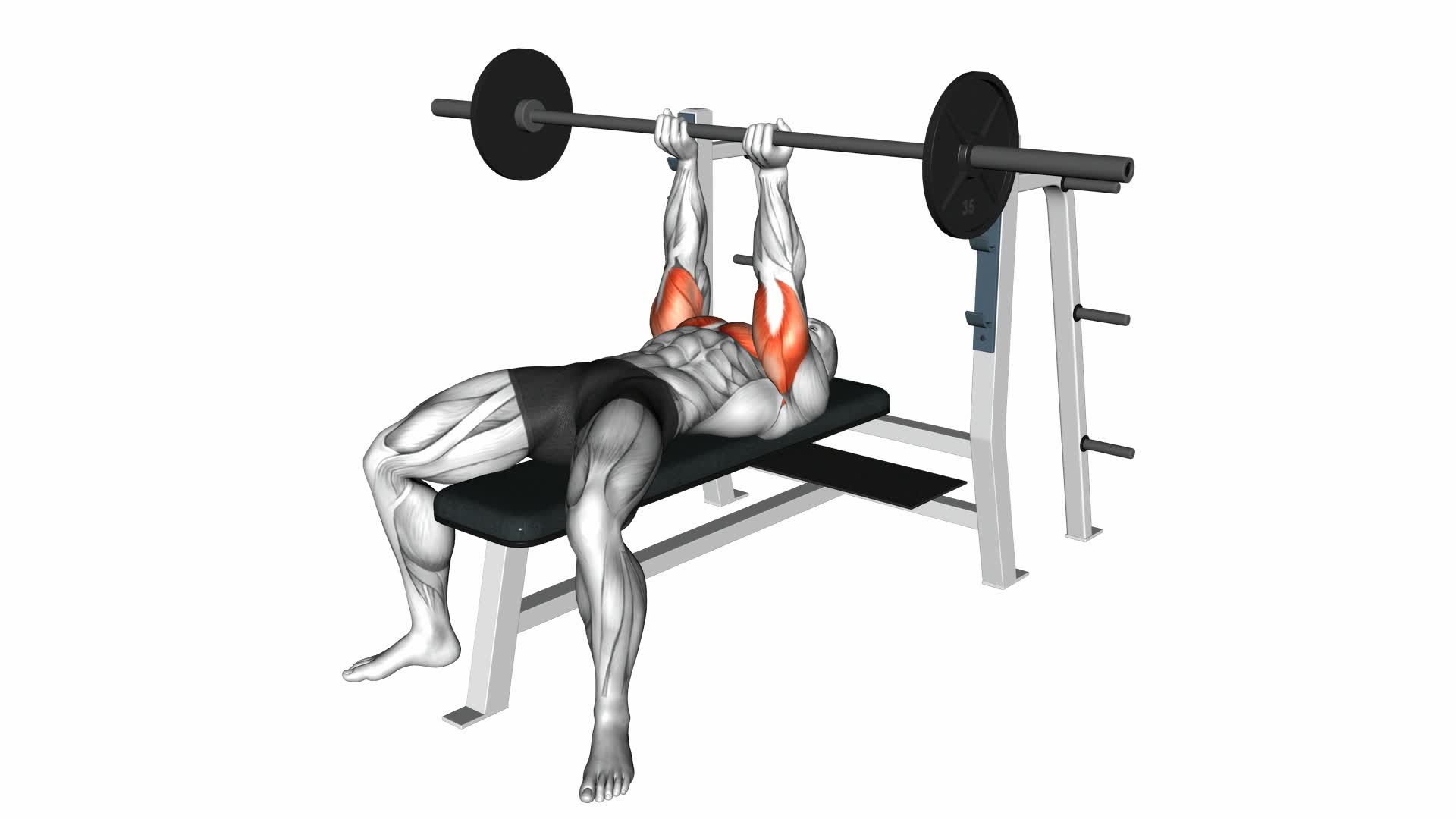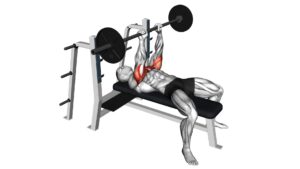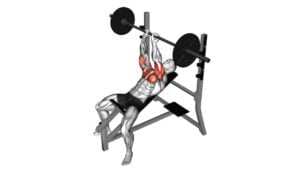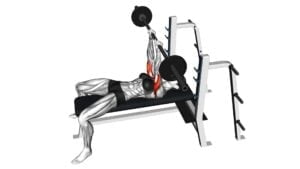Barbell Reverse Close-grip Bench Pres – Video Exercise Guide & Tips

Looking to take your bench press to the next level?
Watch This Exercise Video
In this video exercise guide, we'll walk you through the proper technique for the barbell reverse close-grip bench press.
You'll learn the benefits of this variation and common mistakes to avoid.
Plus, we'll share tips for increasing intensity and progressing with this exercise.
If you're looking for alternative exercises to incorporate, we've got you covered.
Get ready to challenge yourself and achieve your fitness goals with the barbell reverse close-grip bench press.
Key Takeaways
- Maintaining proper technique and form is essential for the Barbell Reverse Close-grip Bench Press, including a firm grip on the barbell and keeping elbows tucked in close to the body.
- The exercise targets the triceps for increased activation and growth, while also improving bench press performance and muscle balance in the upper body.
- Common mistakes to avoid include incorrect elbow position, using too much weight, rushing through the exercise, and compromising form, which can increase the risk of injury.
- To increase intensity and progression, gradually increase weight, use progressive overload techniques, focus on muscle activation at the top of the movement, and listen to your body to avoid injuries.
Proper Technique for Barbell Reverse Close-grip Bench Press
You should always maintain a firm grip on the barbell while performing the reverse close-grip bench press. This exercise targets the triceps, chest, and shoulders, so it's important to execute it with proper technique to maximize its benefits and avoid common errors.
To begin, lie flat on a bench with your feet planted firmly on the ground. Grip the barbell with your palms facing towards you, hands shoulder-width apart, and elbows tucked in close to your sides. Lower the barbell down towards your chest, keeping your elbows in and your wrists straight. Pause for a moment, then push the barbell back up to the starting position, fully extending your arms.
It's crucial to maintain control throughout the movement, avoiding any jerking or bouncing. When performing the reverse close-grip bench press, variations can be made by adjusting the grip width or using different equipment like dumbbells or resistance bands. Remember to start with a weight that challenges you but allows you to maintain proper form.
Benefits of Barbell Reverse Close-grip Bench Press
Maximizing the benefits of the barbell reverse close-grip bench press can be achieved by incorporating variations in grip width and equipment, such as dumbbells or resistance bands, while maintaining proper form throughout the exercise. Here are some key benefits and variations to consider:
- Increased triceps activation: The reverse close-grip bench press primarily targets the triceps, helping to strengthen and tone these muscles effectively. By using a close grip and reversing the hand position, you can place greater emphasis on the triceps, leading to increased muscle activation and growth.
- Improved bench press performance: By incorporating the reverse close-grip bench press into your training routine, you can enhance your overall bench press performance. This exercise can help strengthen the triceps, which are crucial for pushing movements like the bench press. Stronger triceps can contribute to increased strength and stability during the bench press.
- Enhanced muscle balance: The reverse close-grip bench press can also help improve muscle balance in the upper body. By targeting the triceps, this exercise can counterbalance the dominant chest muscles, promoting better overall muscle development and reducing the risk of muscle imbalances.
- Versatility and variety: The barbell reverse close-grip bench press offers various options for customization. You can adjust the grip width, use different equipment like dumbbells or resistance bands, or even incorporate pauses or tempo changes to add variety to your training routine. These variations can help prevent boredom and keep your workouts challenging and engaging.
Common Mistakes to Avoid During Barbell Reverse Close-Grip Bench Press
To avoid common mistakes during the barbell reverse close-grip bench press, it's important to be aware of proper form and technique. One of the most common mistakes people make is incorrect elbow position. When performing this exercise, it's crucial to keep your elbows tucked in close to your body. Allowing your elbows to flare out can put unnecessary stress on your shoulders and increase the risk of injury.
Another mistake to avoid is using too much weight. It's important to start with a weight that you can comfortably lift with proper form. If you try to lift too much weight, you may compromise your form and increase the risk of injury.
Lastly, rushing through the exercise is another common mistake. Take your time and focus on performing each rep with control and precision.
By avoiding these common mistakes, you can ensure that you're getting the most out of your barbell reverse close-grip bench press routine.
Now, let's move on to some tips for increasing intensity and progressing with this exercise.
Tips for Increasing Intensity and Progressing With Barbell Reverse Close-Grip Bench Press
Are you looking to challenge yourself and take your barbell reverse close-grip bench press to the next level? Here are some tips to increase intensity and progress with this exercise:
- Gradually increase weight: Start with a weight that allows you to perform the exercise with proper form. As you get stronger, gradually add more weight to continue challenging your muscles.
- Use progressive overload: To continue making progress, you need to consistently increase the demands on your muscles. This can be done by increasing the weight, the number of sets and repetitions, or decreasing rest time between sets.
- Incorporate advanced techniques: Once you have mastered the basic form, you can add intensity techniques such as drop sets, supersets, or pauses in the bottom position to further stimulate muscle growth.
- Focus on muscle activation: To maximize the effectiveness of the exercise, focus on activating the targeted muscles. Squeeze your chest and triceps at the top of the movement and maintain tension throughout the entire range of motion.
By implementing these progression techniques and emphasizing muscle activation, you can continue challenging yourself and making progress with the barbell reverse close-grip bench press.
Remember to always listen to your body and adjust the intensity accordingly to avoid injuries.
Alternative Exercises to Incorporate With Barbell Reverse Close-Grip Bench Press
As you progress with the barbell reverse close-grip bench press, you can incorporate alternative exercises to further challenge your muscles and enhance your overall training routine. Adding variety to your workouts not only keeps things interesting but also helps prevent plateaus and promotes muscle growth. Here are some alternative exercises that you can incorporate alongside the barbell reverse close-grip bench press.
- Dumbbell Bench Press: This exercise targets the same muscles as the barbell reverse close-grip bench press but allows for a greater range of motion and unilateral training. Grab a pair of dumbbells and perform the bench press with a neutral grip for added shoulder stability.
- Weighted Dips: Dips are a compound exercise that primarily targets the chest, triceps, and shoulders. Adding weight to your dips can further increase the challenge and help develop upper body strength.
- Push-ups: Push-ups are a versatile exercise that can be modified to target different muscle groups. To enhance the challenge, try performing push-ups with your hands close together, similar to the grip used in the reverse close-grip bench press.
- Cable Chest Press: This exercise provides constant tension on the chest muscles throughout the movement. Attach the handles to the cables, adjust the weight, and perform a chest press while keeping your hands close together.
Incorporating these alternative exercises into your routine won't only provide variety but also target your muscles from different angles, leading to greater overall strength and muscle development. Remember to start with lighter weights and gradually increase the load as your strength improves.
Safety Precautions for Barbell Reverse Close-grip Bench Press
When performing the Barbell Reverse Close-grip Bench Press, it's important to pay attention to your elbow position to ensure safety. Keep your elbows tucked in close to your body throughout the exercise to avoid strain or injury.
Additionally, make sure to use a proper grip width, with your hands placed slightly narrower than shoulder-width apart, to maintain control and stability during the movement.
Elbow Position and Safety
To ensure safety during the Barbell Reverse Close-grip Bench Press, it's crucial that you maintain proper elbow position. Proper elbow alignment is essential to prevent unnecessary joint stress and reduce the risk of injury. Here are some important safety precautions to keep in mind:
- Keep your elbows tucked in close to your body throughout the exercise.
- Avoid allowing your elbows to flare out to the sides, as this can place excessive stress on the shoulder joints.
- Maintain a controlled and steady movement, ensuring that your elbows aren't hyperextended or locked out at the top of the movement.
- Use a weight that allows you to maintain proper form and control, as using too heavy of a weight can compromise your elbow position and increase the risk of injury.
Proper Grip Width
For the proper grip width in the Barbell Reverse Close-grip Bench Press, it's important to position your hands close together while maintaining a firm grasp on the barbell. Proper hand placement is crucial to ensure safety and maximize the effectiveness of the exercise.
When gripping the barbell, your hands should be slightly narrower than shoulder-width apart. This close grip targets the triceps muscles and minimizes strain on the shoulders and wrists. However, it's important to note that grip width can vary depending on individual preferences and goals.
Some variations of grip width include a closer grip, where the hands are positioned just a few inches apart, or a wider grip, where the hands are positioned slightly wider than shoulder-width apart. Experiment with different grip widths to find what feels most comfortable and effective for you.
Remember to always maintain a strong and secure grip on the barbell throughout the exercise to prevent accidents or injuries.
Frequently Asked Questions
How Much Weight Should I Start With When Performing the Barbell Reverse Close-Grip Bench Press?
To determine your starting weight for the barbell reverse close-grip bench press, consider your current strength level and experience with the exercise. Starting with a weight that challenges you but allows for proper form is ideal.
This exercise targets your triceps and chest muscles, improving upper body strength and stability.
Gradually increase the weight as you become more comfortable and confident.
Always listen to your body and consult a fitness professional if needed.
Can the Barbell Reverse Close-Grip Bench Press Help Improve My Tricep Strength?
Yes, the barbell reverse close-grip bench press can definitely help improve your tricep strength.
This exercise specifically targets the triceps by placing more emphasis on the back of your arms.
By using a close grip and reversing the movement, you activate the triceps muscles even more.
This exercise is a great addition to your workout routine if you want to build stronger and more defined triceps.
Is It Necessary to Have a Spotter While Performing the Barbell Reverse Close-Grip Bench Press?
When performing the barbell reverse close-grip bench press, having a spotter isn't necessary but highly recommended. A spotter can provide assistance and help ensure your safety, especially when lifting heavy weights.
If you don't have a spotter, consider using alternative exercises like dumbbell tricep extensions or cable pushdowns. These exercises can still effectively target and strengthen your triceps without the need for a spotter.
Remember to always prioritize safety and listen to your body during your workouts.
Can I Perform the Barbell Reverse Close-Grip Bench Press if I Have Shoulder or Wrist Issues?
If you have shoulder or wrist issues, it may not be ideal to perform the barbell reverse close-grip bench press. However, there are modifications and alternative exercises available that can help you work around these issues.
It's important to prioritize your safety and avoid any exercises that cause pain or discomfort. Consulting with a fitness professional or physical therapist can provide you with personalized guidance on suitable exercises and modifications for your specific needs.
How Often Should I Include the Barbell Reverse Close-Grip Bench Press in My Workout Routine for Optimal Results?
To maximize your results, it's important to include the barbell reverse close-grip bench press in your workout routine.
This exercise targets your triceps, chest, and shoulders, helping to build strength and improve upper body muscle definition.
Aim to perform this exercise 2-3 times a week, allowing for adequate rest days in between.
Remember to start with lighter weights and gradually increase the load as your strength improves.
Always listen to your body and modify the exercise if you have any shoulder or wrist issues.
Conclusion
In conclusion, the Barbell Reverse Close-grip Bench Press is a highly effective exercise for targeting the triceps and chest muscles. By using a close grip and reversing the movement, you can engage these muscles in a unique way and challenge them to grow stronger.
It's important to maintain proper technique, avoid common mistakes, and gradually increase intensity to ensure safety and maximize results. Consider incorporating alternative exercises to add variety to your workout routine.
Keep these tips in mind to make the most out of your training sessions.

Author
Years ago, the spark of my life’s passion ignited in my mind the moment I stepped into the local gym for the first time. The inaugural bead of perspiration, the initial endeavor, the very first surge of endorphins, and a sense of pride that washed over me post-workout marked the beginning of my deep-seated interest in strength sports, fitness, and sports nutrition. This very curiosity blossomed rapidly into a profound fascination, propelling me to earn a Master’s degree in Physical Education from the Academy of Physical Education in Krakow, followed by a Sports Manager diploma from the Jagiellonian University. My journey of growth led me to gain more specialized qualifications, such as being a certified personal trainer with a focus on sports dietetics, a lifeguard, and an instructor for wellness and corrective gymnastics. Theoretical knowledge paired seamlessly with practical experience, reinforcing my belief that the transformation of individuals under my guidance was also a reflection of my personal growth. This belief holds true even today. Each day, I strive to push the boundaries and explore new realms. These realms gently elevate me to greater heights. The unique combination of passion for my field and the continuous quest for growth fuels my drive to break new ground.







